May 11 2017
Two rest days and a hard session (lactate, lactate!)
Monday was a travel and tourism day, and tuesday was a very long day at work, and after the long weekend I was behind on a couple of important work related duties, as well as evening conference calls with final reviews of some project proposals, so I had to skip training. I didn’t mind much. I think a 2 day gap now and then, when life and work get in the way, is actually quite healthy and definitely not detrimental.
This also gave me a motivation to do a really hard training, although I chickened out of what our head coach had posted on the training plan board:
2x(7×50″/10″) @ 34-36 spm, 5 minutes rest between the 2 sets
That is like 30 strokes “on”, 3 strokes “rest”, for 7 minutes, at a stroke rate that I cannot hold for 4 minutes. Driving to the rowing club, I was thinking of what to do with these instructions. I was also curious to see how many of our Masters rowers would turn up on this Wednesday and what boat type I would row.
Turns out that through back injuries, work related duties, business travel, we had 4 rowers of our eight, plus 1 younger guy who rows with the Masters group occasionally. The issue, however, was that that one guy is not comfortable rowing a single, and one of the others is not a sculler. He only rows sweep. I got a little impatient when we hadn’t decided after 25 minutes so I announced that I would go in the single (which would also enable me to row my own session). The sweep rower Bulda teamed up with Krocan to take a pair, and the remaining two got out in a double.
We have the full Albano lanes out because of the International Youth Regatta of coming weekend, so I wanted to do 2x”something intensive at high stroke rates” in the 2k course. My training phase prescribes ANC training, which is short intervals with rest, and many of them, to get the body to produce lactate (as fuel, which I will condition the body to use in the subsequent phase).
[amazon_link asins=’B00O5Y4FXA’ template=’ProductAd’ store=’rowingdata-20′ marketplace=’US’ link_id=’d9b314bd-3613-11e7-8a0e-454df77c6fc6′]
After 2k of warming up, I stopped to fiddle with my HR strap. I had the feeling that it was too lose and that I felt the strap on my back creeping down slowly. So I tried to adjust it back, which led to it snapping. The Wahoo Tickr straps connect with snap fasteners to the sensor “pod”. They call it the “two-snap” connection which is easy to get on and off. Well. It snapped. Under two layers of clothing (because it was cold), with me being in a single on cold water.
So I removed the upper part of my uni, clamped the scull handles between my belly and my legs, and tried to use two hands to snap on the HR strap. Initially, I failed, and I ended up holding only the sensor, with the strap being somewhere under my clothes, and discovering that my left blade had turned and was now perpendicular to the water, in flipping position. I corrected that, and proceeded to struggle. In the end I managed to snap everything back on and get my clothes in order as well. Without flipping.
Krocan proposed 20 strokes “on”, 10 strokes “off”, and that seemed a very good compromise. At this point, I was incorrectly remembering the training schedule and thinking that there were 3 series of 50″/10″, so I agreed with his proposal, thinking that we would 3 full 2k distances of them.
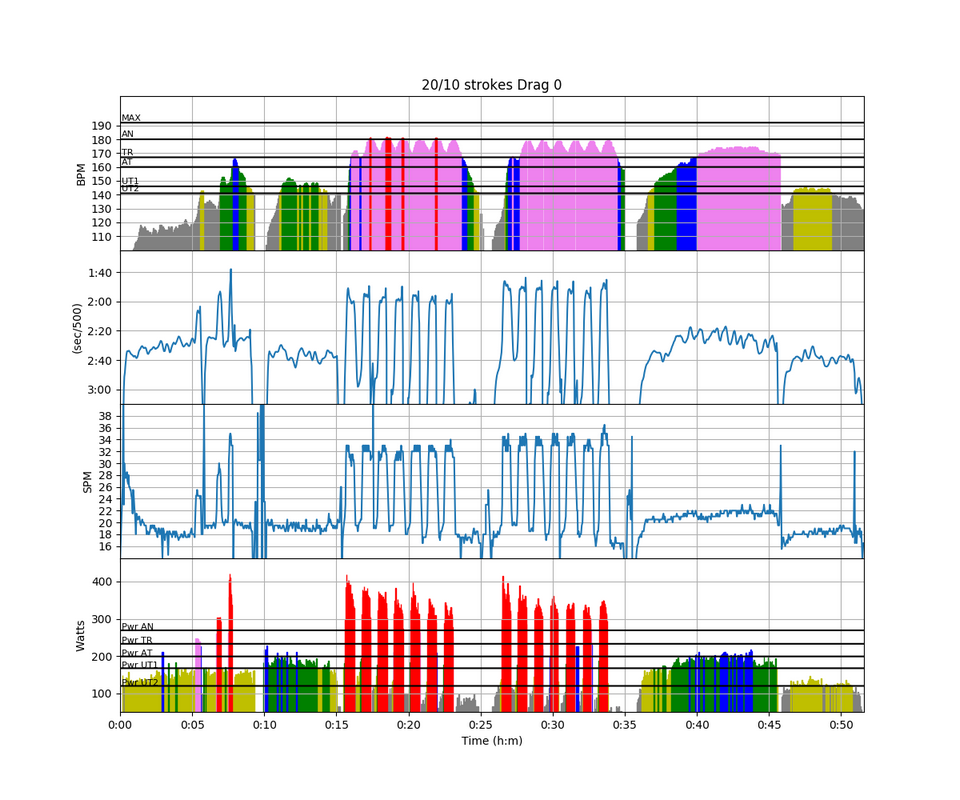
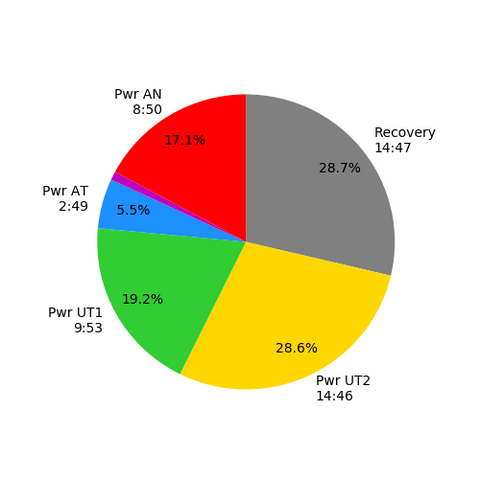
It was nice to row this next to the pair. I called out every eigth stroke of the paddle and grunted after the 20th (final) stroke of each interval. I managed to beat them by about a length over one entire 2k course. Looking at the graph, I see we did only 7 intervals per 2k. It felt more like 9 or 10. Anyway, after the first (headwind) and second (tailwind) 2k all three of us were so worn out that we couldn’t think of doing another series. So we just rowed the final 2k at steady state pace, followed by a cooling down.
During the intervals, I saw how I achieved fewer and fewer Watts as the intervals went on. Here, I am trying to see if that is a result of reduced force, length, stroke rate, or both. Stroke rate is excluded. You can already see from the overview chart above that the stroke rate didn’t drop. Here is a look at peak and average force.
In the these two plots, you can see that the effective drive length also drops, especially as I am shorter on the finish. I focused on not tapping down too late, because I noticed a very strong effect on “wash”, and also it makes it easier to keep the stroke rate high.
The next plot shows the same, but with effective drive length (taking into account slip and wash) instead of total drive length. I am running my effective drive length at 85% of total drive length. I would be interested to see the values of other people.
I also added a plot of the result, Work per Stroke, for the “on” intervals.
Here are some typical values according to Nielsen-Kellerman, compared to a summary for my “on” strokes. The values closest to my stroke are indicated with the colored cells. I guess I am just lacking in power and strength.
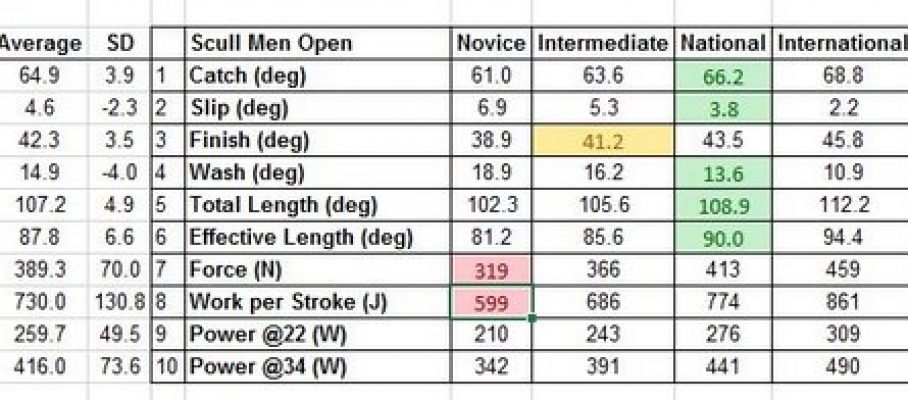
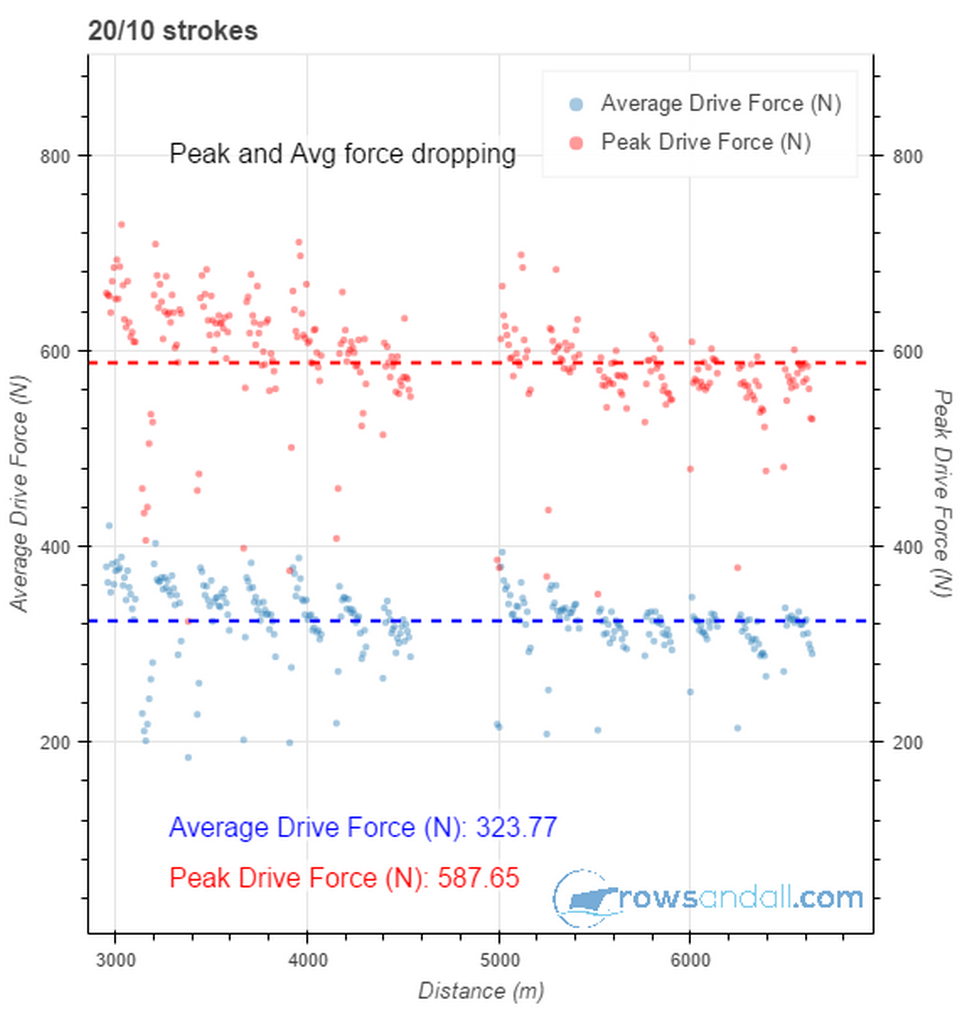
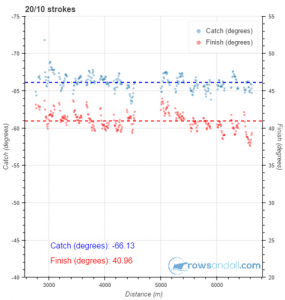
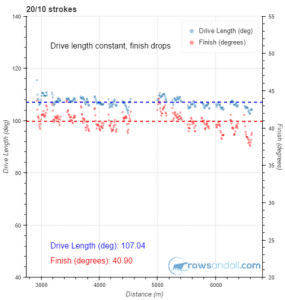
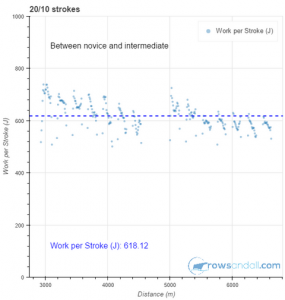
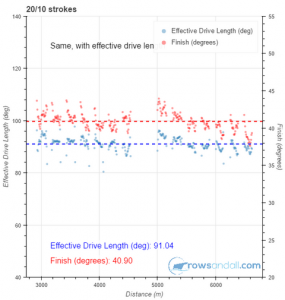
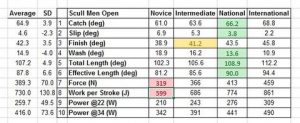
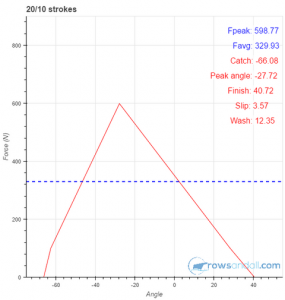

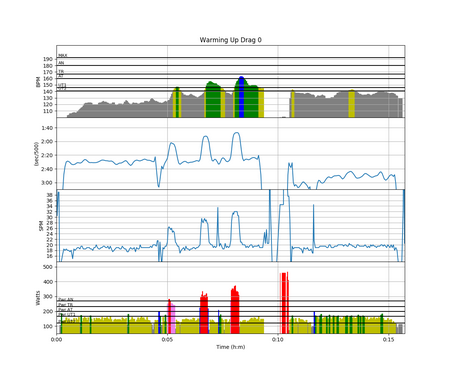

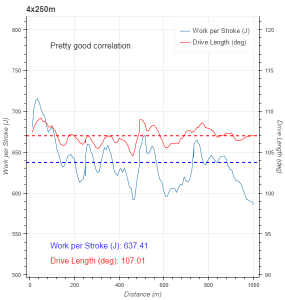
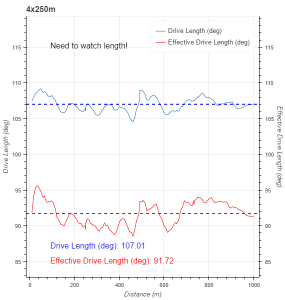
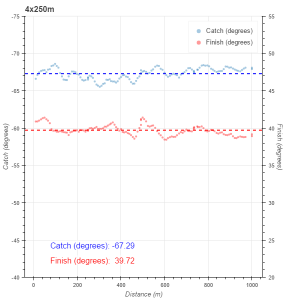
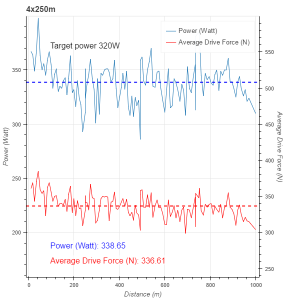
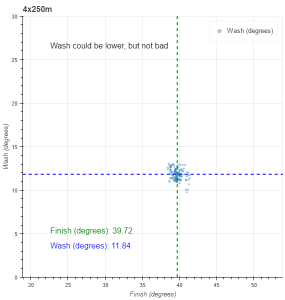
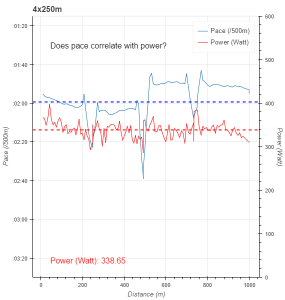

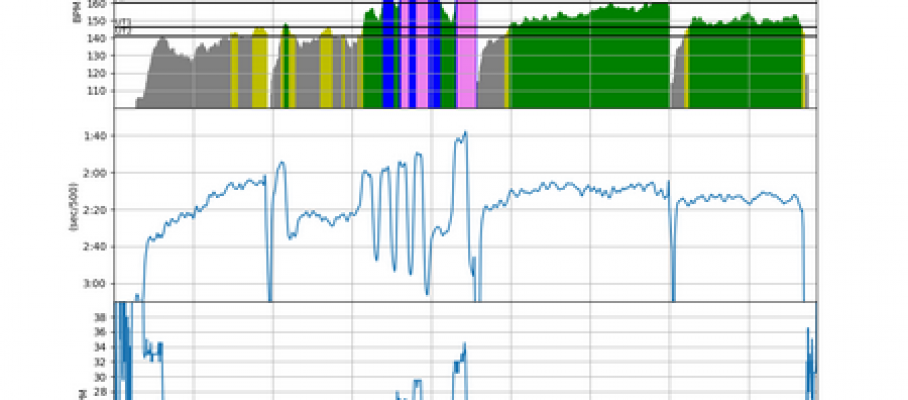
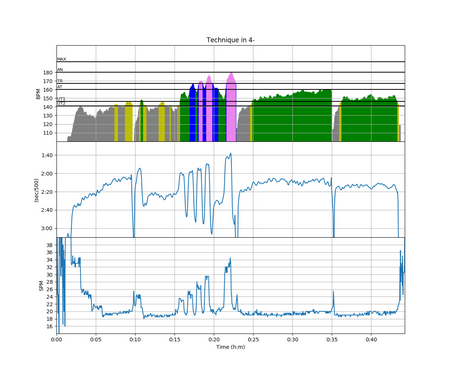
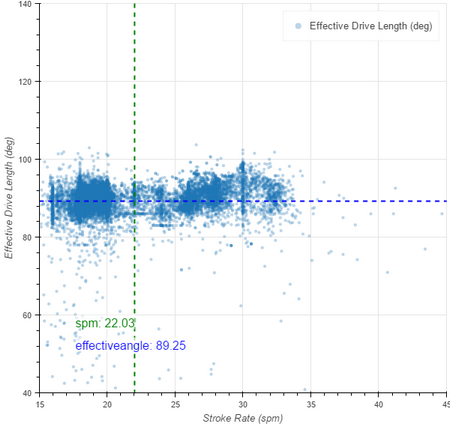
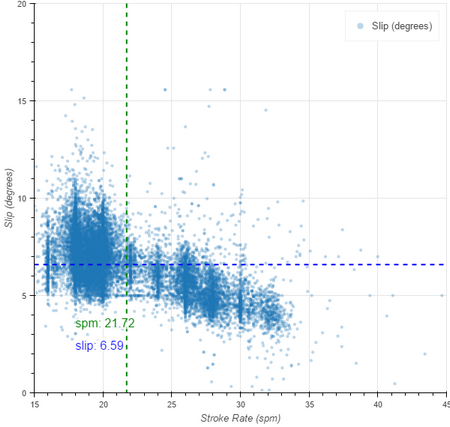
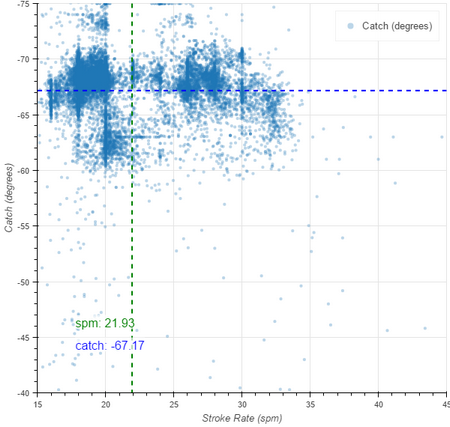
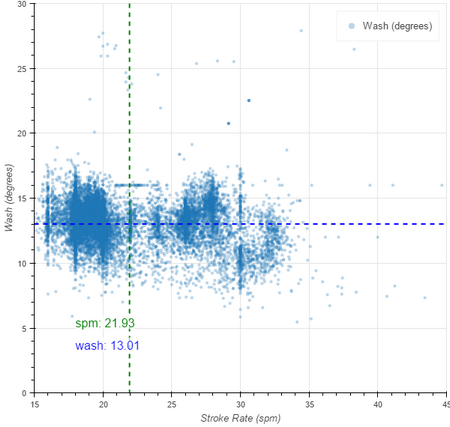

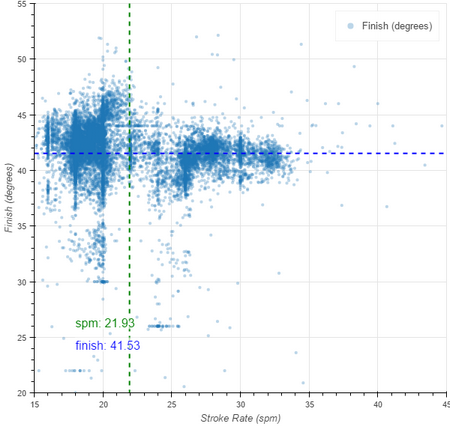
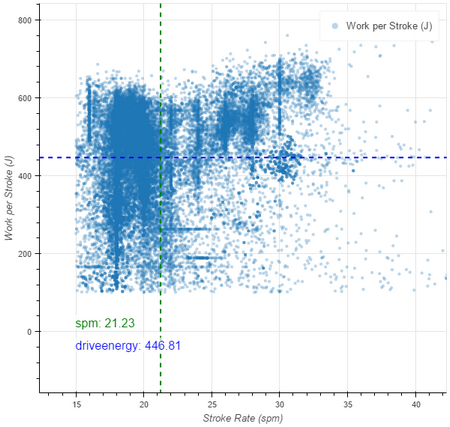
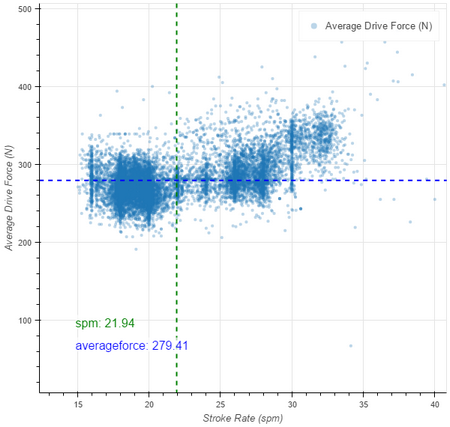
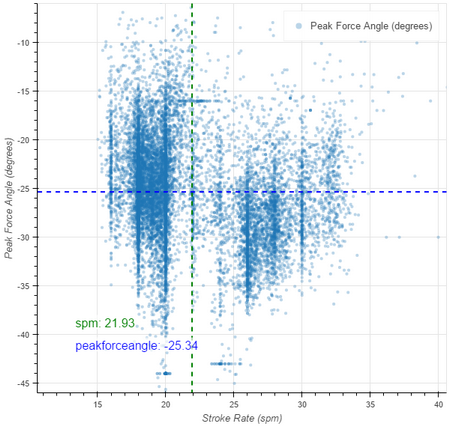
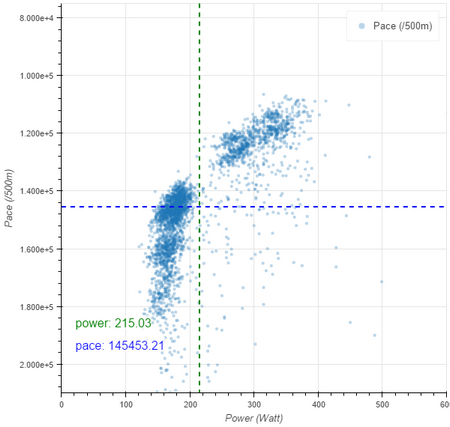
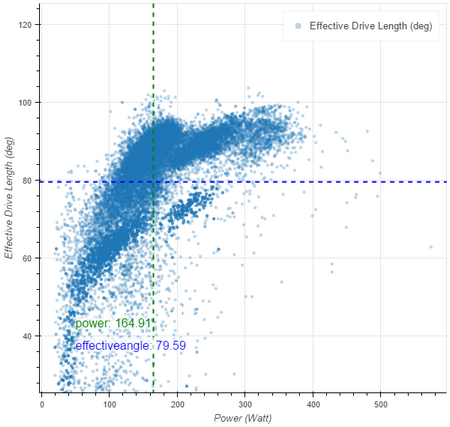
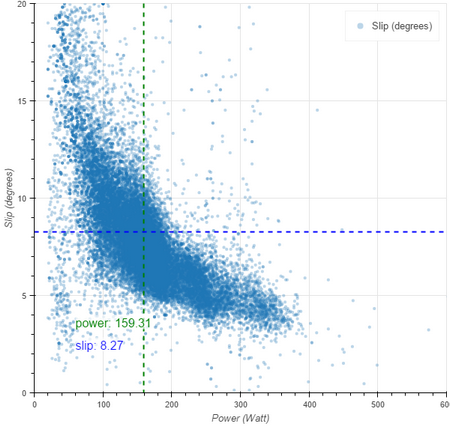
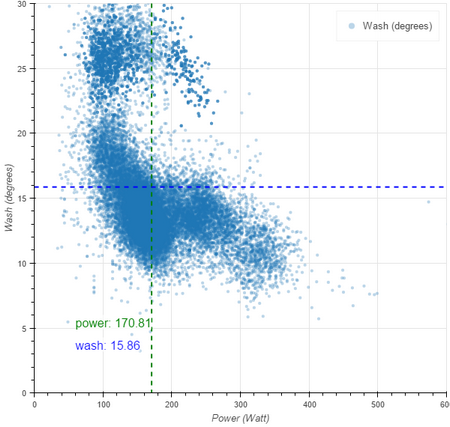
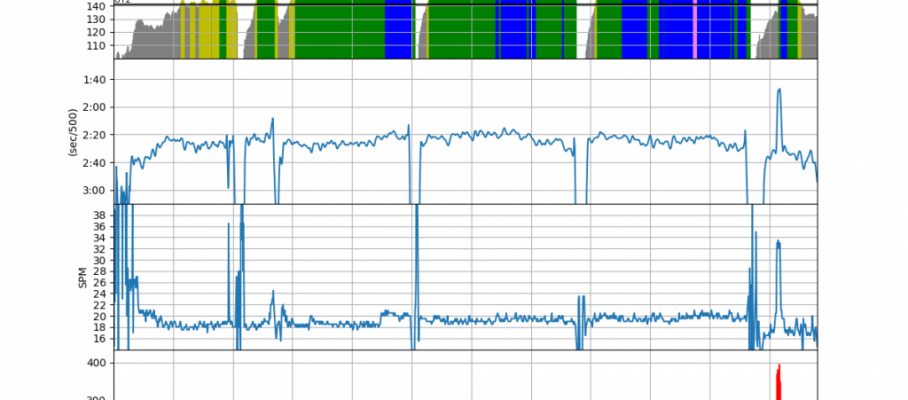
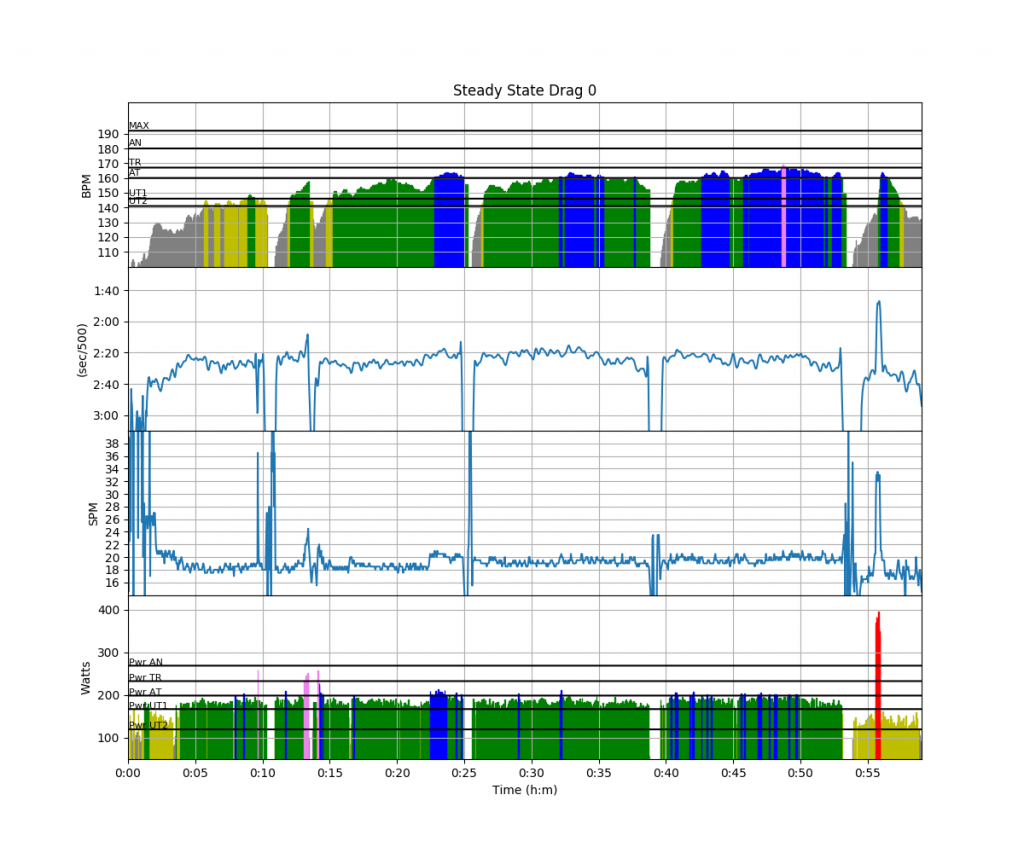
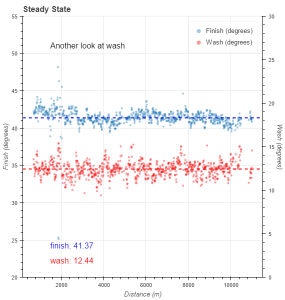
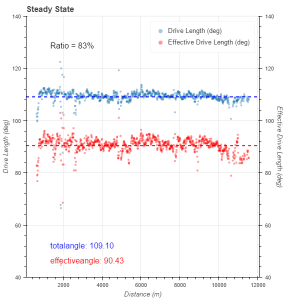
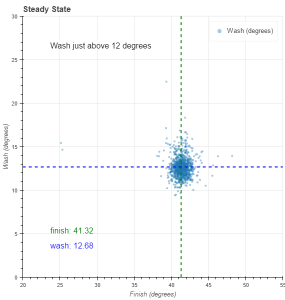
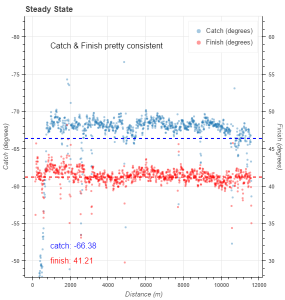
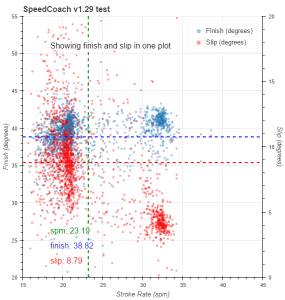

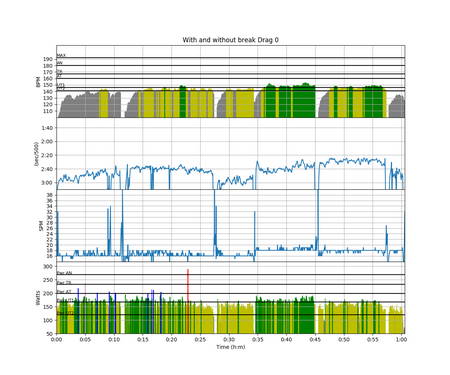
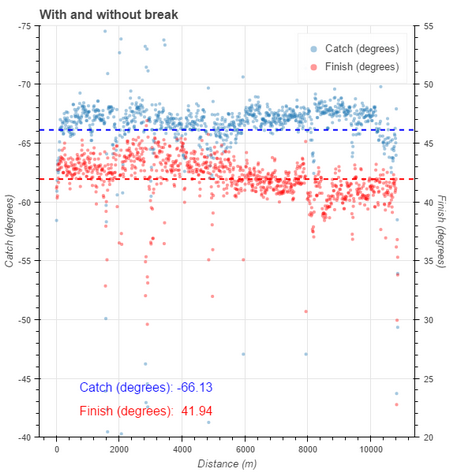
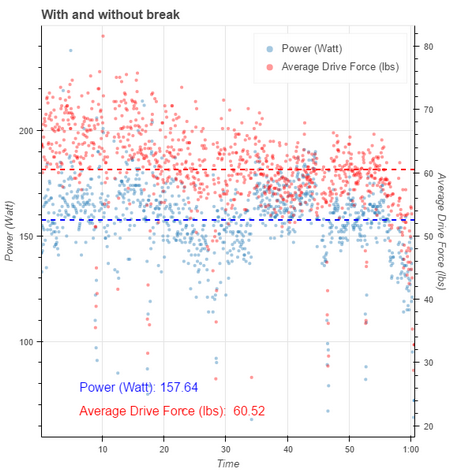
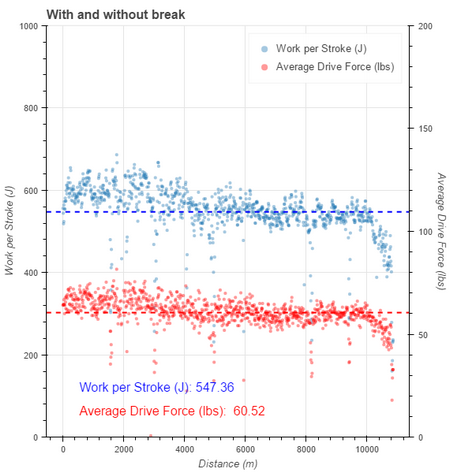
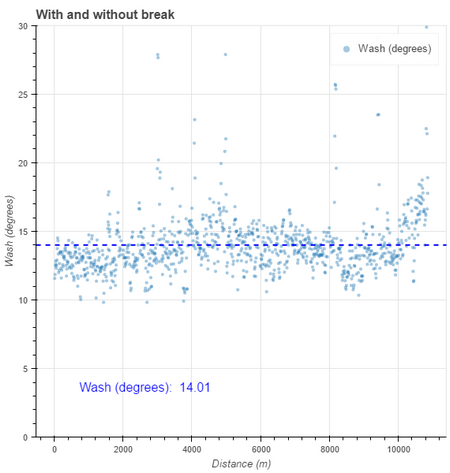
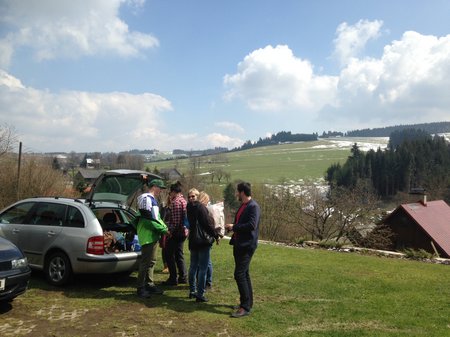


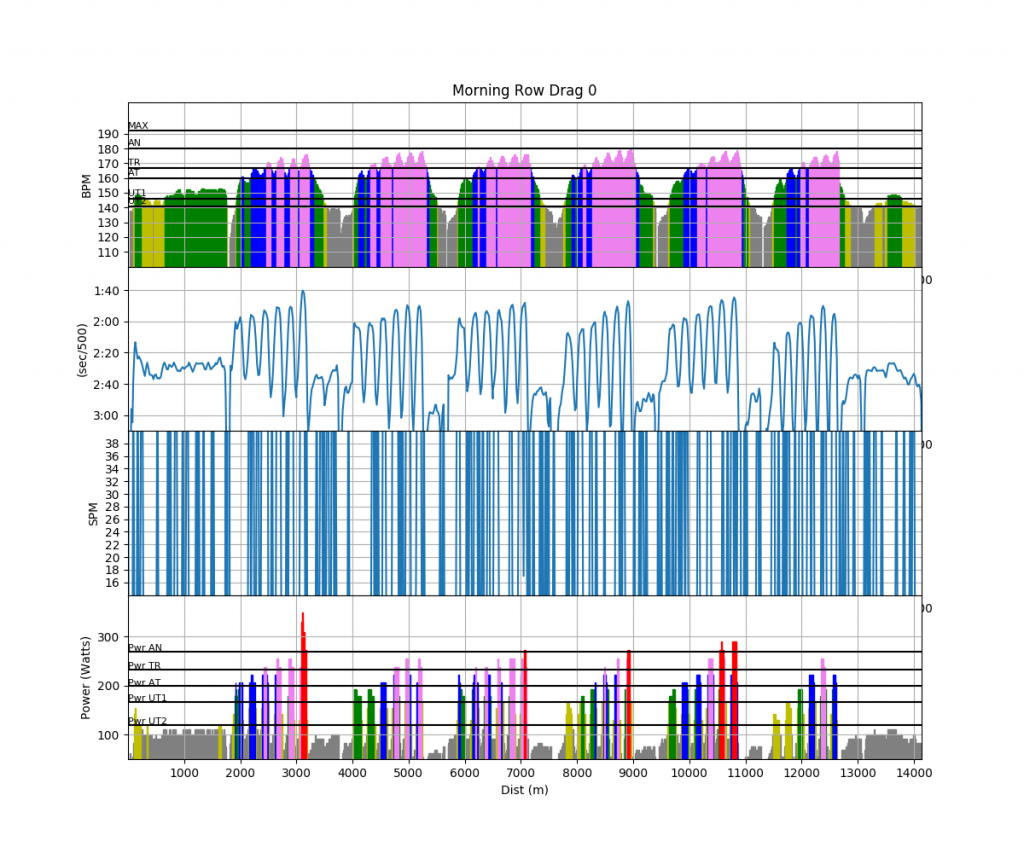
May 24 2017
Monday – Boat Washing & Tuesday – Steady State & Training Planning
Monday – Boat Washing
I was hesitating if I should take a rest day or not after the races, but during the working day on Monday I made the decision to rest. Four times 1k in one weekend is not a very heavy training load, but you add to that the stress of boat transport, race management, and other things and then it is understandable why I didn’t feel like training much.
The plan changed when I made a phone call with our club’s president who reminded me that we had agreed to row in the eight on Monday. OK. So I was going to make an exception for training in the eight. We haven’t had a single session with the complete line-up and I haven’t rowed in the eight a single time, having work travel interfere. The race is on June 3. Actually, I personally tried to persuade the team that it doesn’t make sense to row this race. Part of the team is undertrained. Some of them haven’t really managed their weight, and some of them have injuries. I did reject an offer from a faster eight out of club loyalty, but this year the eight has not been a good experience.
I decided to head to the club earlier than our 6pm agreed time and get my boats off the trailer and prepare them for the next few weeks of training. That means washing, checking, and jotting down equipment replacement items that I need to purchace at the next occasion.
6pm. Three of the eight had arrived.
6:30pm. Seven out of the eight had arrived, but we could row if the cox would row and one of our Juniors could cox. Unfortunely, the Junior’s mother did not allow that. The guy had to be at home doing homework.
7pm. I drove home.
In the evening I took a detailed look at the programs for Bled (World Masters Regatta) and Trebon (Czech Masters Open), because the weekend in Hodonin had resulted in some offers and requests. Oh, the days when coaches made line-ups! Now, as a Master, it is a complex dance of who wants to row with whom, which combination would be fast, and keeping track of half and full promises made, as well as the actual race schedule. Also, you can be sure that in parallel other rowers are exploring options, so there is no time to wait for the best offer. For me personally, club loyalty, personal sympathies and speed potential are almost equal parameters in the equation.
Tuesday – Steady State
I didn’t sleep well, was up very early, so I decided to row early and have more time for a session before work than usual. The training plan had “Race SPM+2” intervals, but driving to the rowing club I considered swapping this for a longer steady state session. I had done enough of sprinty work (at race pace) over the weekend and I knew that the eight training on Wednesday (if there would be one) would be biased to doing speed work as well (although that will be very painful speed work when you haven’t done base rowing together). I want to respect a rough 80/20 division of base work versus high intensity work. Finally, my legs were very clearly not recovered from the weekend activities. As our rowing club is on a hill, putting out the sculls you climb and descend a bit and that is always a good moment to “feel” how recovered you are. Not recovered.
So Steady State it was going to be. It turned out to be a great session. A gray morning, back on my home lake, lots of race moments from the past weekend to replay in the mind, and relatively flat water, so working on boat run would be possible.
I did 6 minute rate ladders (3′ @ 18 / 2′ @ 20 / 1′ @ 22), which fit nicely into the 13 minute, 3km lake. Did 4 full lake lengths, plus 2km warmingup and 2km cooling down. Some metrics plots with self-explanatory comments:
And here is how this session (the last box) compares with comparable sessions over the past month, for a few metrics:
The session on April 23 was an Indoor Rower workout which I accidentally added to the selection. Instead of redoing all the plots, I decided to leave the data there. Just for fun, I decided to look at heart rate vs distance for all those sessions:
Doing this from the Team page on Rowsandall.com, I accidentally added a workout by Greg Smith into the mix (sorry Greg). It’s a little bit a “bowl of spagetthi chart”. I think these comparisons are easier when you pick two sessions.
Training Planning
I have spent my car driving time catching up with the excellent rowing training science podcasts from bRowShow and that inspired me to take a critical look at how I am doing this season, and evaluating if I need to change the training blocks in the run-up to the Czech Masters Open (middle July) and Worlds Masters Regatta (early September).
This first plot is from Stravistix, and it shows training volume (in hours) vs date for the past few years. This is quite a fun plot, because it falsifies my feeling that I am doing less volume than last year. In terms of hours trained, the numbers are quite comparable.
Here is how my training load and performance looks on SportTracks.mobi:
And here is an equivalent graph from the desktop version of SportTracks:
And here is the Stravistix version:
It’s interesting to see how much difference a slightly different setting of the integration constants makes. So my Cumulative Training load and Accute Training load seem to be lower than a year ago, but the Performance is similar? Interesting. I guess the races will prove this, but it is true that I don’t feel like I am slower than a year ago. It is also interesting to see that even though Stravistix tells me that my training hours, YTD, are quite similar, the training load numbers of the two SportTracks versions are more in line with my feeling that I am doing less volume. The training load number for Stravistix suggests that this year is a copy of 2016.
Anyway, it is what it is. I cannot magically add training volume in the next couple of weeks. So this is the state of my training bank account and now I have to decide how to invest in the coming few weeks. Here is roughly how I am going to do it (and feel free to critique):
10000 feet view
June – Anaerobe Capacity / Anaerobe Power
July – Explosive Power, Lactate Tolerance, Speed
August – Repeat
Week level view
Week 21-22 – Lactate Production
Week 23-25 – Threshold Training (using lactate as fuel)
Week 26-28 – Lactate Tolerance and Speed
Week 29-30 – Cross Training, Lactate Production (away from rowing water) – and rethink training plan
Week 31-33 – Threshold
Week 34-36 – Lactate Tolerance and Speed
Of course, this is just what I am doing in the 20%. The rest will be base steady state, technique, cross-training. We’re going to spend 2 weeks in the mountains on vacation. I am going to lobby for taking the mountainbikes, because I think that the MTB could be a nice way to do short interval bursts (riding uphill).
By sanderroosendaal • Uncategorized • 4 • Tags: lake, OTW, rowing, single, training